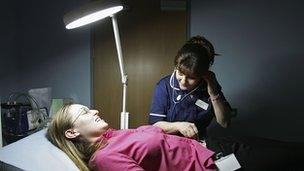The riddle of walk-in centres
- Published

Walk-in health centres were meant to be more convenient for patients
NHS walk-in centres sound like a good idea.
Open until late into the evening - or sometimes round-the-clock - they can provide a wide range of non-emergency care.
In fact, they became a key policy initiative under Labour.
Known as Darzi centres - after the then health minister and leading surgeon Professor Lord Darzi - 150 were opened after 2008.
It now means there are more than 350 in total. Some are called walk-in centres, while others are known as urgent care centres.
In theory, they should be playing an invaluable role, as A&E units threaten to buckle under the pressure being placed on them.
But it is not quite that simple. As demands have started to grow on A&E, reports have begun to emerge of walk-in centres closing.
Concerns have grown so much that the regulator Monitor has launched a review into why this is happening and how it is affecting patients.
The obvious answer is that with money short, clinical commissioning groups, which now hold the purse strings for local services, have decided to make savings.
But it has also been clear for some time that all has not been well with the walk-in centre service.
One of the problems is that what is offered varies greatly from place to place.
Some are staffed by doctors, others are not, which can cause difficulties for patients needing prescriptions.
Some have x-ray facilities, others do not. There is very little consistency.
Unsurprisingly, this has caused a great deal of confusion among patients and perhaps explains why some centres have proved popular (mostly in urban areas) and others have not.